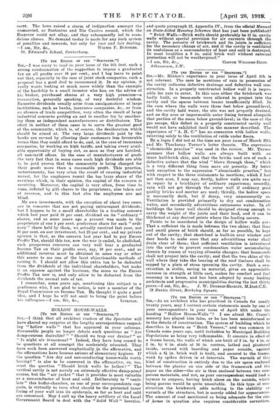HOLLOW HOUSE-WALLS.
[To TRE EDITOR or TEE " SPEOTATOR."3 Sus,—I think that all architect readers of the Spectator will have shared my surprise at the lengthy correspondence respect- ing "hollow walls" that has appeared in your columns. Reasonable people no longer debate such questions as " Are dampcourses deeirable?" " Should we trap our drains?" or " Is night air innocuous?" Indeed, they have long ceased to be questions at all amongst the moderately educated. They have each been answered emphatically .in the affirmative, and the affirmations have become axioms of elementary hygiene. If the question "Are dry and non-conducting house-walls worth having?" is also to be answered in the affirmative, so, too, must the question "Should brick walls be hollow?" The vertical cavity is not merely an extremely effective damp-proof course, but the "air jacket" that it provides is most valuable as a non-conductor of heat and cold. Deliberately bo " venti- late" this buffer-chamber, as one of your correspondents sug- gests, is virtually to turn what should be the protected inner lining of your wall into its epidermis, so far as heat and cold are concerned. May I call up the heavy artillery of the Local Government Board to deal with the "Solid Wall" heretics. and quote paragraph 12, Appendix IV., from the official Manual on State-Aided Housing Schemes that has just been•published?
"Brick Walls.—Brick walls should preferably be 11 in. cavity walls without special provision for air currents through the cavity. The porosity of brickwork and its joints insufficient for the necessary change of air, and if the cavity is ventilated its usefulness as a non-conductor of heat and cold is destroyed. In most localities a 9 in. solid brick wall without external protection will not be weatherproof."






































 Previous page
Previous page